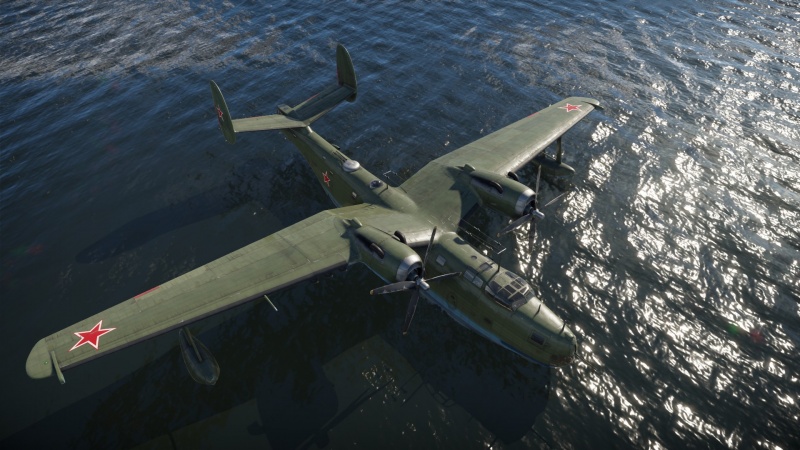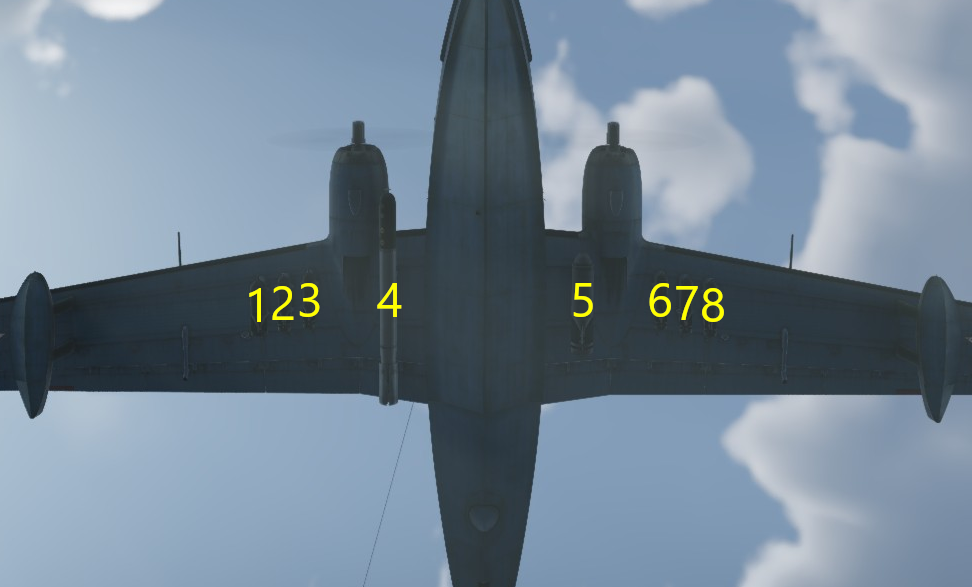Be-6
Contents
Description
The Be-6 was a Soviet multi-purpose flying boat designed with the intent of carrying out various maritime missions. The primary purposes for which it was designed were anti-submarine warfare, transport operations, and reconnaissance missions. It was developed in the late 1940s by Beriev OKB and first flew in 1949. The Be-6 was equipped with powerful ASH-73 engines and a large fuel capacity, allowing it to fly for an extended period of time and possibly cover more than 4,000 kilometres without refuelling. It was remarkably well protected for its time, with five powerful NR-23 cannons mounted in the nose and tail turrets, providing effective defense against possible aerial threats. The aircraft served for quite a long time, considering the rapid technological advancement during that era, and wasn't retired until the late 1960s.
The Be-6 was introduced as a premium pack in Update 1.71 "New E.R.A" and was discontinued from the store after the 2018 Victory Day sales, but returned during War Thunder's 6th Anniversary as a premium purchasable with Golden Eagles ![]() . One of its most notable features is its defensive armament, which consists of five NR-23s, making it one of the most heavily armed bombers in the game. Furthermore, its maximum payload can take out two bases in air realistic battles, which is quite impressive given its other capabilities.
. One of its most notable features is its defensive armament, which consists of five NR-23s, making it one of the most heavily armed bombers in the game. Furthermore, its maximum payload can take out two bases in air realistic battles, which is quite impressive given its other capabilities.
General info
Flight performance
| Characteristics | Max Speed (km/h at 2,135 m) |
Max altitude (metres) |
Turn time (seconds) |
Rate of climb (metres/second) |
Take-off run (metres) | |||
|---|---|---|---|---|---|---|---|---|
| AB | RB | AB | RB | AB | RB | |||
| Stock | 397 | 386 | 29.1 | 30.1 | 7.2 | 7.1 | 1,000 | |
| Upgraded | 441 | 418 | 26.9 | 28.0 | 11.1 | 9.0 | ||
Details
| Features | ||||
|---|---|---|---|---|
| Combat flaps | Take-off flaps | Landing flaps | Air brakes | Arrestor gear |
| ✓ | ✓ | ✓ | X | X |
| Limits | ||||||
|---|---|---|---|---|---|---|
| Wings (km/h) | Gear (km/h) | Flaps (km/h) | Max Static G | |||
| Combat | Take-off | Landing | + | - | ||
| 500 | 291 | 279 | 220 | ~5 | ~3 | |
| Optimal velocities (km/h) | |||
|---|---|---|---|
| Ailerons | Rudder | Elevators | Radiator |
| < 350 | < 350 | < 350 | > 300 |
Survivability and armour
- 8 mm steel - behind each pilot
- 10 mm steel - around tail guns
- 9.5 mm steel - between tail guns and gunners window
- 105 mm bulletproof glass - tail gunner's window
Modifications and economy
Armaments
Suspended armament
The Be-6 can be outfitted with the following ordnance:
| 1 | 2 | 3 | 4 | 5 | 6 | 7 | 8 | ||
|---|---|---|---|---|---|---|---|---|---|
| 250 kg FAB-250M-46 bombs | 1 | 1 | 1 | 1 | 1 | 1 | 1 | 1 | |
| 500 kg FAB-500M-46 bombs | 1 | 1 | 1 | 1 | 1 | 1 | 1 | 1 | |
| 1,500 kg FAB-1500M-46 bombs | 1 | 1 | |||||||
| 450 mm 45-36MAN torpedoes | 1 | 1 | |||||||
| Maximum permissible loadout weight: 4,400 kg Maximum permissible wing load: 2,200 kg Maximum permissible weight imbalance: 1,800 kg | |||||||||
| Default weapon presets | |
|---|---|
| |
Defensive armament
The Be-6 is defended by:
- 1 x 23 mm NR-23 cannon, nose turret (100 rpg)
- 2 x 23 mm NR-23 cannons, dorsal turret (250 rpg = 500 total)
- 2 x 23 mm NR-23 cannons, tail turret (225 rpg = 450 total)
Usage in battles
The best payload for base bombing is the 8 x 500 kg option, allowing you to take out two bases (requiring 4 bombs each). The 2 x 1,500 kg option is rarely recommended (except maybe when airfield bombing) as both bombs drop at once, limiting you to one base or target, and because the total bomb load is also reduced from 4,000 kg to 3,000 kg .
A different approach is to select the airfield spawn (you spawn just above the runway) and the hug the ground, either attacking ground targets or bases (if there are any left). This has the advantage of meaning your team mates will be more likely to cover you (they don't have to climb up to your altitude), and makes you harder to spot for enemy aircraft. It also means enemy aircraft cannot get below you and exploit your blind spot. However you will likely be to slow to kill bases if there are any other bombers on your team (they will get their first). It is also not recommended to bomb the airfield at low altitude as you will be food for the AAA.
Keep a constant lookout and use your potent defensive armament to dispatch of attacking enemy aircraft as quickly as possible.
Manual Engine Control
| MEC elements | ||||||
|---|---|---|---|---|---|---|
| Mixer | Pitch | Radiator | Supercharger | Turbocharger | ||
| Oil | Water | Type | ||||
| Controllable | Controllable Auto control available |
Not controllable Not auto controlled |
Controllable Not auto controlled |
Combined | Not controllable 1 gear |
Auto controlled |
Pros and cons
Pros:
- Good, destructive defensive armament
- Good bomb load (can kill two bases in RB)
- Turns fairly well
- Has two pilots (less chance of them being killed)
- Can land on water
- Can take a reasonable amount of damage
Cons:
- Drops bombs in pairs halving number of targets you can hit (i.e. 8 bombs gives you 4 drops)
- Big target
- Engines are exposed and liable to be set on fire
- Turrets can not cover underneath
- Not the most stable of bombing platforms
- Lack of landing gear can make re-arming interesting on some maps (still possible but harder)
- Large control surfaces make big targets
- Fairly slow
- Very poor roll rate
- Not much ammo for the turrets
History
The first prototype of the Be-6 flew in 1945, only a couple years after the initial plans for the new Soviet flying boat were laid down in 1943. Evaluation of the first prototype showed that the aircraft could be improved in some areas to achieve better performance. Thus, Beriev engineers equipped the following model, that would become the production version, with more powerful Shvetsov ASh-73 engines and changed the defensive armaments layout from six 12.7 mm UBT machine guns to 23 mm NR-23 cannons, followed by the reduction in turret count from 5 to 3. This improved variant had its maiden flight in 1951, with serial production following shortly after.
After its introduction to service in 1951, the Be-6 was tasked with performing various roles fitted for a maritime aircraft, such as reconnaissance, sub-hunting, patrolling, transportation and mine-laying. The aircraft enjoyed a long service life thanks to the fact that significant changes within the Soviet navy, at least when float planes were concerned, were few and far between during the Cold War. However, the Be-6 didn't only serve with the Soviet Union. The Chinese also received a number of Be-6s for their naval air force. The Be-6 remained in active military service with the Soviet Union until the late 1960's, and up to the 1990's with the Chinese Naval Air Force, thanks to modernization efforts. The Chinese changed, among other things, the powerplant of the Be-6 to the WJ-6 turboprop and redesignated the Be-6 to the Qing-6. A total of around 120 Be-6s were produced between 1949 - 1957.
- From Devblog
Media
- Skins
- Videos
See also
Links to the articles on the War Thunder Wiki that you think will be useful for the reader, for example:
- reference to the series of the aircraft;
- links to approximate analogues of other nations and research trees.
External links
- [Devblog] Beriev Be-6 - "The Arctic Seagull"
- Official data sheet - more details about the performance
| Beriev Design Bureau (Бериева Опытное конструкторское бюро) | |
|---|---|
| Bombers | MBR-2-M-34 · Be-6 |
| Recon | KOR-1 |
| USSR bombers | |
|---|---|
| SB and Ar | SB 2M-100 · SB 2M-103 · SB 2M-103 MV-3 · SB 2M-103U · SB 2M-103U MV-3 · SB 2M-105 · Ar-2 |
| Yer-2 (petrol) | Yer-2 (M-105) · Yer-2 (M-105) TAT · Yer-2 (M-105R) TAT · Yer-2 (M-105R) LU |
| Yer-2 (diesel) | Yer-2 (ACh-30B) (e) · Yer-2 (ACh-30B) (l) |
| Tu | Tu-2 · Tu-2S · Tu-2S-44 · Tu-2S-59 · Tu-4 |
| Pe | Pe-2-1 · Pe-2-31 · Pe-2-83 · Pe-2-110 · Pe-2-205 · Pe-2-359 · Pe-8 |
| IL | DB-3B · IL-4 |
| Po | Po-2 · Po-2M |
| Other | MBR-2-M-34 · TB-3M-17-32 · Yak-4 · Be-6 |
| Lend-Lease | ▂PBY-5A Catalina · ▂Hampden TB Mk I · ▂A-20G-30 · ▂B-25J-30 |
| USSR premium aircraft | |
|---|---|
| Fighters | Krasnolutsky's I-15bis · I-16 type 28 · Zhukovsky's I-153-M62 · I-153P · I-180S · I-301 · ITP (M-1) |
| LaGG-3-4 · LaGG-3-23 · LaGG-3-34 · Dolgushin's La-7 · La-11 | |
| Eremin's Yak-3(e) · Yak-3 (VK-107) · Yak-3T · Golovachev's Yak-9M | |
| ▂P-39K-1 · ▂Pokryshkin's P-39N-0 · ▂P-39Q-15 · ▂P-40E-1 · ▂P-47D-27 · ▂P-63A-5 · ▂P-63A-10 · ▂P-63C-5 | |
| ▂Hurricane Mk IIB · ▂Spitfire Mk IXc · ▂Fw 190 D-9 | |
| Twin-engine fighters | I-29 |
| Jet fighters | Su-11 · MiG-15bis ISh · MiG-17AS · MiG-21S (R-13-300) · MiG-23ML |
| Strike aircraft | IL-2M "Avenger" · IL-2 M-82 · IL-8 (1944) · Su-6 · Tandem MAI · TIS MA · Su-8 · Tu-1 |
| Yak-38 · Su-7BMK · Su-25K · Su-39 | |
| Bombers | Po-2M · Be-6 · MBR-2-M-34 · Pe-2-205 · TB-3M-17-32 |
| ▂PBY-5A Catalina · ▂Hampden TB Mk I · ▂A-20G-30 · ▂B-25J-30 | |






